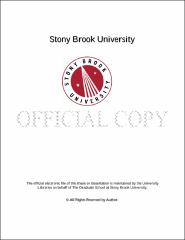| dc.identifier.uri | http://hdl.handle.net/11401/76473 | |
| dc.description.sponsorship | This work is sponsored by the Stony Brook University Graduate School in compliance with the requirements for completion of degree. | en_US |
| dc.format | Monograph | |
| dc.format.medium | Electronic Resource | en_US |
| dc.language.iso | en_US | |
| dc.publisher | The Graduate School, Stony Brook University: Stony Brook, NY. | |
| dc.type | Dissertation | |
| dcterms.abstract | The bromodomain and extra-terminal (BET) protein BRD4 is a validated drug target in hematological malignancies, owing to its essential role in sustaining oncogenic transcriptional programs. To gain insight into the cancer-relevant mechanistic function of BRD4, I have investigated its mechanism of transcriptional activation in the MLL-fusion subtype of acute myeloid leukemia (AML) with experimental approaches including small hairpin RNA (shRNA) knockdown, clustered regularly-interspaced short palindromic repeats (CRISPR)-Cas9 knockout, biochemistry, RNA sequencing (RNA-Seq) and chromatin immunoprecipitation sequencing (ChIP-Seq). In this study, I demonstrate that the AML maintenance function of BRD4 requires its interaction with NSD3, which belongs to a subfamily of H3K36 methyltransferases. Unexpectedly, AML cells were found to only require a short isoform of NSD3 that lacks the methyltransferase domain. I show that NSD3-short is an adaptor protein that sustains leukemia by linking BRD4 to the CHD8 chromatin remodeler, by utilizing a Pro-Trp-Trp-Pro (PWWP) module, and by employing an acidic transactivation domain. Phenotypic and transcriptional effects of genetic targeting of NSD3 or CHD8 mimic the effects of BRD4 inhibition. Furthermore, BRD4, NSD3, and CHD8 colocalize across the AML genome and are each released from super-enhancer regions upon chemical inhibition of BET bromodomains. These findings suggest that BET inhibitors exert therapeutic effects in leukemia by evicting BRD4-NSD3-CHD8 complexes from chromatin to suppress transcription. | |
| dcterms.available | 2017-09-20T16:50:21Z | |
| dcterms.contributor | Vakoc, Christopher R. | en_US |
| dcterms.contributor | Krainer, Adrian R. | en_US |
| dcterms.contributor | Trotman, Lloyd C. | en_US |
| dcterms.contributor | Mills, Alea A. | en_US |
| dcterms.contributor | Luk, Ed | en_US |
| dcterms.contributor | Hammell, Christopher M. | en_US |
| dcterms.creator | Shen, Chen | |
| dcterms.dateAccepted | 2017-09-20T16:50:21Z | |
| dcterms.dateSubmitted | 2017-09-20T16:50:21Z | |
| dcterms.description | Department of Molecular and Cellular Biology | en_US |
| dcterms.extent | 199 pg. | en_US |
| dcterms.format | Monograph | |
| dcterms.format | Application/PDF | en_US |
| dcterms.identifier | http://hdl.handle.net/11401/76473 | |
| dcterms.issued | 2016-12-01 | |
| dcterms.language | en_US | |
| dcterms.provenance | Made available in DSpace on 2017-09-20T16:50:21Z (GMT). No. of bitstreams: 1
Shen_grad.sunysb_0771E_12779.pdf: 5245454 bytes, checksum: a75bc0b1ef46e172656fb8dc902a5564 (MD5)
Previous issue date: 1 | en |
| dcterms.publisher | The Graduate School, Stony Brook University: Stony Brook, NY. | |
| dcterms.subject | Biology -- Molecular biology -- Genetics | |
| dcterms.subject | cancer, epigenetics, leukemia, transcriptional regulation | |
| dcterms.title | Mechanistic evaluation of NSD3 in the pathogenesis of acute myeloid leukemia | |
| dcterms.type | Dissertation | |

